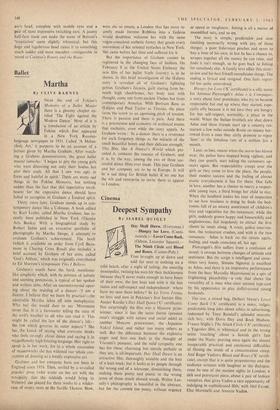Ballet
Martha
By CLIVE BARNES NEAR the end of Fokine's Memoirs of a Ballet Master there is a gloomy chapter en- titled 'The Fight against the Modern Dance.' Most of it is 4 translation of an article by Fokine which Mt appeared in a New York Russian- language newspaper in 1931. Called 'A Melan- choly Art,' it purports to be an account of a lecture given by Martha Graham. After watch- ing 4.1 Graham demonstration, the great ballet master remarks.: 'I began to pity the young girls who were distorting not only their bodies but also their souls. All that I saw was ugly in form and hateful in spirit.' There are many sad things in the Fokine Memoirs, but nothing sadder than the fact that this superlative torch- bearer for the expressive dance should have failed to recognise in Graham a tindred spirit.
Thirty years later, Graham stands up in con- temporary dance like a Colossus. A book edited by Karl Leabo, called Martha Graham, has re- cently been published in New York (Theatre Arts Books). With a. biographical study by Robert Sabin and an evocative portfolio of photographs by Martha Swope, it attempts to evaluate Graham's achievement. The book (which is available on order from Cyril Beau- mont in Charing Cross Road) also includes a brief account by 'Graham of her aims, called 'God's Athlete,' which was originally contributed to Ed Murrow's symposium This I Believe.
Graham's words have the hard, manifesto- like simplicity which, with its mixture of naivety and seeming pretension, is typical of her spoken and written aims. After an uncontroversial open- ing about the training of a dancer—'I am a dancer. I believe that we learn by practice'—the admirable Martha takes of into metaphysics. Who but she would dare to say 'Movement never lies. It is a barometer telling the state of the soul's weather to all who can read it. This might be called the law of the dancer's life— the law which governs its outer aspects'? She has the knack of saying what everyone thinks who feels strongly about dance and saying it in magnificently high-faluting language. Her right to speak is in her work, for in a whole succession of masterworks she has widened our whole con- ception of dancing as a totally expressive art.
Graham and her company have not been in England since 1954. Then, reviled by a so-called popular press (who wrote on her art with the tensipility that the tabloids would bring to ‘Vebern). she played for three weeks to a wilder- ness of 'empty seats at the Saville Theatre. Now, were she to return, a London that has more re- cently made Jerome Robbins into a fashion would doubtless welcome her with the same vogue-conscious esthetic frenzy that greets every movement of her oriental eyelashes in New York. She came before her time and suffered for it.
But the importance of Graham cannot be registered in the changing face of fashion. On February 8 at the United States Embassy the new film of her ballet Nigh! Journey is to be shown.. In this brief investigation of the CEdipus story is revealed all of Graham's lightning genius. Graham's Jocasta, guilt staring from be- neath high cheekbones, her body taut with thought, came not from ancient Thebes but from contemporary America. With Bertram Ross as (Edipus and Paul Taylor' as Tiresias, the piece turns the screw to an agonising pitch of tension. There is passion and there is pain. And there is. a preciseness and economy of technical means that enchants, even while the story appals. As Graham wrote : 'In a dancer there is a reverence for such forgotten things as the miracle of the small beautiful boneS and their delicate strength.' This film, like A Dancer's World which pre- ceded it, contains the essence of. Graham; and it is, by the. way, among the two or three suc- cessful da'nce films ever made. This year Graham and her company are to be in Europe. It will be a sad thing for British ballet if no one has the wit and enterprise to invite them to appear in 1.ondon.


































 Previous page
Previous page